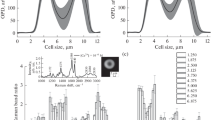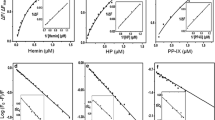Abstract
We investigate the interaction of Ca2+ (0–500 µM) and a membrane mimic (0.60 mM SDS) with both the R- and mixed spin states hemoglobin S (HbS) as a function of time. These interactions were carried out at pH 5.0. We aim at ascertaining if there is or are differences in the UV–Visible spectra of such interactions to account for the dynamics of calcium ion concentrations [Ca2+] in initiating structures which may ultimately suggest HbS polymerization and or resistance to Plasmodium attack. From our results, we conclude that (a) simultaneous interaction of 40 µM Ca2+ and 0.60 mM SDS with the R state protein would promote structural formations that can “lock up” the protein for nucleation on the membranes and or become cytotoxic to the parasite; (b) simultaneous R state HbS-SDS or R state HbS-Ca2+ would lead to enhanced hemin formation and less deoxyHb species. This condition is unlikely to precipitate polymerization in the HbS but the resulting hemin would poison the parasite; (c) the mixed spin state HbS-SDS and 40 µM Ca2+ interaction yields more toxic products to that of the interaction of the mixed spin HbS-SDS with 500 µM Ca2+ thus suggesting why the 40 µM Ca2+ is important in parasite Hb proteolysis; and (d) pronounced structural changes on interaction with SDS and Ca2+ are more in the R state to the mixed spin state.




Similar content being viewed by others
References
Chilaka, F. C., Nwamba, C. O., & Moosavi-Movahedi, A. A. (2011). Cation modulation of hemoglobin interaction with sodium n-dodecyl sulfate (SDS). I. Calcium modulation at pH 7.20. Cell Biochemistry and Biophysics, 60, 187–197.
Nwamba, C. O., Chilaka, F. C., & Moosavi-Movahedi, A. A. (2011). Cation modulation of hemoglobin interaction with sodium n-dodecyl sulfate (SDS). II. Calcium modulation at pH 5.0. Cell Biochemistry and Biophysics, 61, 573–584.
Marva, E., & Hebbel, R. P. (1994). Denaturing interaction between sickle hemoglobin and phosphatidylserine liposomes. Blood, 83, 242–249.
Akompong, T., Ghori, N., & Haldar, K. (2000). In vitro activity of riboflavin against the human malaria parasite Plasmodium falciparum. Antimicrobial Agents and Chemotherapy, 44, 88–96.
Williams, T. N., Mwangi, T. W., Roberts, D. J., Alexander, N. D., Weatherall, D. J., Wambua, S., et al. (2005). An immune basis for malaria protection by the sickle cell trait. PloS Medicine, 2, 0441–0445.
Cholera, R., Brittain, N. J., Gillrie, M. R., Lopera-Mesa, T. M., Diakité, S. A. S., Arie, T., et al. (2008). Impaired cytoadherence of Plasmodium falciparum-infected erythrocytes containing sickle hemoglobin. Proceedings of the National Academy of Sciences of the United States of America, 105, 991–996.
Ivanov, V. T., Karelin, A. A., Philippova, M. A., Nazimov, I. V., & Pletnev, V. Z. (1997). Hemoglobin as a source of endogenous bioactive peptides: The concept of tissue-specific peptide pool. Biopolymers, 43, 171–188.
Machado, A., Sforça, M. L., Miranda, A., Daffre, S., Pertinhez, T. A., Spisni, A., et al. (2007). Truncation of amidated fragment 33–61 of bovine α-hemoglobin: Effects on the structure and anticandidal activity. Biopolymers (Peptide Science), 88, 413–426.
Hubber, S. M., Uhlemann, A.-C., Gamper, N. L., Duranton, C., Kremsner, P. G., & Lang, F. (2002). Plasmodium falciparum activates endogenous Cl− channels of human erythrocytes by membrane oxidation. European Molecular Biology Organization Journal, 21, 22–30.
Gazarini, M. L., Thomas, A. P., Pozzan, T., & Garcia, C. R. S. (2003). Calcium signalling in a low calcium environment: How the intracellular malaria parasite solves the problem. Journal of Cell Biology, 161, 103–110.
Kirk, K. (2001). Membrane transport in the malaria-infected erythrocyte. Physiological Review, 81, 495–537.
Eaton, J. W., Skelton, T. D., Swofford, H. S., Kolpin, C. E., & Jacob, H. S. (1973). Elevated erythrocyte calcium in sickle cell disease. Nature, 246, 105–106.
Kelemen, C., Chien, S., & Artmann, G. M. (2001). Temperature transition of human hemoglobin at body temperature: Effects of calcium. Biochemical Journal, 80, 2622–2630.
Orjih, A. U. (2001). On the mechanism of hemozoin production in malaria parasites: Activated erythrocyte membranes promote β-hematin synthesis. Experimental Biology and Medicine, 226, 746–752.
Mooren, Ch. F., & Kinne, R. K. H. (1998). Cellular calcium in health and disease. Biochimica et Biophysica Acta, 1406, 127–151.
Shin, I., Kreimer, D., Silman, I., & Weiner, L. (1997). Membrane-promoted unfolding of acetylcholinesterase: A possible mechanism for insertion into the lipid bilayer. Proceedings of the National Academy of Sciences of the United States of America, 94, 2848–2852.
Tanaka, A., & Hoshino, E. (2003). Similarities between the thermal inactivation kinetics of Bacillus amyloliquefaciens α-amylase in an aqueous solution of sodium dodecyl sulphate and the kinetics in the solution of anionic phospholipid vesicles. Biotechnology and Applied Biochemistry, 38, 175–181.
Antonini, E., & Brunori, M. (1971). The derivatives of ferrous hemoglobin and myoglobin. In A. Neuberger & E. L. Tatum (Eds.), Hemoglobin and myoglobin in their reactions with ligands (Vol. 21, pp. 13–39). Amsterdam: North-Holland Publishing Co.
Goldstein, S., & Samuni, A. (2005). Intra- and intermolecular oxidation of oxymyoglobin and oxyhemoglobin induced by hydroxyl and carbonate radicals. Free Radical Biology & Medicine, 39, 511–519.
Wetlaufer, D. B., Edsall, J. T., & Hollingworth, B. R. (1958). Ultraviolet difference spectra of tyrosine groups in proteins and amino acids. Journal of Biological Chemistry, 233, 1421–1428.
Sinha, K. K., & Udgaonkar, J. B. (2007). Dissecting the non-specific and specific components of the initial folding reaction of barstar by multi-site FRET measurements. Journal of Molecular Biology, 370, 385–405.
Lorenz, T., & Reinstein, J. (2008). The influence of proline isomerization and offpathway intermediates on the folding mechanism of eukaryotic UMP/CMP kinase. Journal of Molecular Biology, 381, 443–455.
Aoki, K., & Foster, J. F. (1957). Electrophoretic behaviour of bovine plasma albumin at low pH. Journal of American Chemical Society, 79, 3385–3393.
Otzen, D. E., & Oliveberg, M. (2002). Burst-phase expansion of native protein prior to global unfolding in SDS. Journal of Molecular Biology, 315, 1231–1240.
Aoki, K., & Foster, J. F. (1957). Electrophoretic and hydrogen ion binding behaviour of bovine plasma albumin in the presence of 0.02 M thiocyanate ion. Journal of American Chemical Society, 79, 3393–3396.
Tanford, C. (1957). The acid denaturation of ferrihemoglobin (Communications to the editor). Journal of American Chemical Society, 79, 3931–3932.
Dadlez, M. (1999). Folding initiation sites and protein folding. Acta Biochimica Polonica, 46, 487–508.
Kirby, E. P., & Steiner, R. F. (1970). The tryptophan microenvironments in apomyoglobin. Journal of Biological Chemistry, 245, 6300–6306.
Tanabe, K. (1990). Ion metabolism in malaria infected erythrocytes. Blood Cells, 16, 437–449.
He, K., He, Y. A., Szklarz, G. D., Halpert, J. R., & Correia, M. A. (1996). Secobarbital-mediated inactivation of cytochrome P450 2B1 and its active site mutants: Partitioning between heme and protein alkylation and epoxidation. Journal of Biological Chemistry, 271, 25864–25872.
He, K., Woolf, T. F., & Hollenberg, P. F. (1999). Mechanism-based inactivation of cytochrome P-450-3A4 by Mifepristone (RU486). Journal of Pharmacological and Experimental Therapeutics, 288, 791–797.
Egawa, T., Hishiki, T., Ichikawa, Y., Kanamori, Y., Shimada, H., Takahashi, S., et al. (2004). Refolding processes of cytochrome P450cam from ferric and ferrous acid forms to the native conformation: Formations of folding intermediates with non-native heme coordination state. Journal of Biological Chemistry, 279, 32008–32017.
Kristinsson, H. G. (2002). Acid-induced unfolding of flounder haemoglobin: Evidence for a molten globular state with enhanced pro-oxidative activity. Journal of Agricultural and Food Chemistry, 50, 7669–7676.
Boffi, A., Das, T. K., della Longa, S., Spagnuolo, C., & Rousseau, D. L. (1999). Pentacoordinate hemin derivatives in sodium dodecyl sulfate micelles: Model systems for the assignment of the fifth ligand in ferric heme proteins. Biophysical Journal, 77, 1143–1149.
Asakura, T., Minakata, K., Adachi, K., Russell, M. O., & Schwartz, E. (1977). Denatured hemoglobin in sickle erythrocytes. Journal of Clinical Investigation, 59, 633–640.
Rifkind, J. M., Abugo, O., Levy, A., & Heim, J. (1994). Detection, formation, and relevance of hemichromes and hemochromes. Methods in Enzymology, 231, 449–480.
Pan, W., Uzunova, V. V., & Vekilov, P. G. (2009). Free heme in micromolar amounts enhances the attraction between sickle cell hemoglobin molecules. Biopolymers, 91, 1108–1116.
Lew, V. L., Hockaday, A., Sepulveda, M. I., Somlyo, A. P., Somlyo, A. V., Ortiz, O. E., et al. (1985). Compartmentalization of sickle cell calcium in endocytic inside-out vesicles. Nature (London), 315, 586–589.
Murphy, E., Berkowitz, L. R., Orringer, E., Levy, L., Gabel, S. A., & London, R. E. (1987). Cytosolic free calcium levels in sickle red blood cells. Blood, 69, 1469–1474.
Eisinger, J., Flores, J., & Salhany, J. M. (1982). Association of cytosol hemoglobin with the membrane in intact erythrocytes. Proceedings of the National Academy of Sciences of the United States of America, 79, 408–412.
Hebbel, R. P., Morgan, W. T., Eaton, J. W., & Hedlund, B. E. (1988). Accelerated autoxidation and heme loss due to instability of sickle hemoglobin. Proceedings of the National Academy of Sciences of the United States of America, 85, 237–241.
Evans, E. A., & Mohandas, N. (1987). Membrane-associated sickle hemoglobin: A major determinant of sickle erythrocyte rigidity. Blood, 70, 1443–1449.
Lew, V. L., & Bookchin, R. M. (2005). Ion transport pathology in the mechanism of sickle cell dehydration. Physiological Review, 85, 179–200.
Briehl, R. W., & Herzfeld, J. (1979). Tactoidal state and phase transitions in systems of linear polymers of variable length. Proceedings of the National Academy of Sciences of the United States of America, 76, 2740–2744.
Dobson, C. M. (2005). Summary of the horizon symposium on “protein folding and disease”. Horizon symposium on protein folding and disease (pp. 1–7). Retrieved November 25, 2005 from http://www.nature.com/horizon/proteinfolding/pdf/summary.pdf.
Slemmon, J. R., Hughes, C. M., Campbell, G. A., & Flood, D. G. (1994). Increased levels of hemoglobin-derived and other peptides in Alzheimer’s disease cerebellum. Journal of Neurosciences, 14, 2225–2235.
Fogaça, A. C., da Silva (Jr), P. I., Miranda, M. T. M., Bianchi, A. G., Miranda, A., Ribolla, P. E. M., et al. (1999). Antimicrobial activity of a bovine hemoglobin fragment in the tick Boophilus microplus. Journal of Biological Chemistry, 274, 25330–25334.
Lombardo, M. E., Araujo, L. S., Ciccarelli, A. B., & Batlle, A. (2005). A spectrophotometric method for estimating hemin in biological systems. Analytical Biochemistry, 341, 199–203.
Giulivi, C., & Davies, K. J. A. (1994). Hydrogen-peroxide mediated ferrylhemoglobin generation in vitro and in red blood cells. Methods in Enzymology, 231, 490–496.
Kuželová, K., Mrhalová, M., & Hrkal, Z. (1997). Kinetics of heme interaction with heme-binding proteins: The effect of heme aggregation state. Biochemica et Biophysica Acta, 1336, 497–501.
Egawa, T., Shimada, H., & Ishimura, Y. (2000). Formation of compound I in the reaction of native myoglobins with hydrogen peroxide. Journal of Biological Chemistry, 275, 34858–34866.
Brown, N. A., King, R. F. G. J., Shillcock, M. E., & Brown, S. B. (1974). Haemoglobin catabolism: The role of ferrihaems in studies of the degradation pathway. Biochemical Journal, 137, 135–137.
Brown, S. B., Dean, T. C., & Jones, P. (1970). Catalatic activity of iron(III)-centred catalysts: Role of dimerization in the catalytic action of ferrihaems. Biochemical Journal, 117, 741–744.
Brown, S. B., Shillcock, M., & Jones, P. (1976). Equilibrium and kinetic studies of the aggregation of porphyrins in aqueous solution. Biochemical Journal, 153, 279–285.
Graça-Souza, A. V., Maya-Monteiro, C., Paiva-Silva, G. O., Braz, G. R. C., Paes, M. C., Sorgine, M. H. F., et al. (2006). Adaptations against heme toxicity in blood-feeding arthropods. Insect Biochemistry and Molecular Biology, 36, 322–335.
Tekwani, B. L., & Walker, L. A. (2005). Targeting the hemozoin synthesis pathway for new antimalarial drug discovery: Technologies for in vitro β-hematin formation assay. Combinatorial Chemistry & High Throughput Screening, 8, 63–79.
Author information
Authors and Affiliations
Corresponding author
Rights and permissions
About this article
Cite this article
Nwamba, C.O., Chilaka, F.C. & Moosavi-Movahedi, A.A. Cation Modulation of Hemoglobin Interaction with Sodium n-Dodecyl Sulfate (SDS). III: Calcium Interaction with R- and Mixed Spin States of Hemoglobin S at pH 5.0: The Musical Chair Paradox. Cell Biochem Biophys 67, 547–555 (2013). https://doi.org/10.1007/s12013-013-9540-9
Published:
Issue Date:
DOI: https://doi.org/10.1007/s12013-013-9540-9




